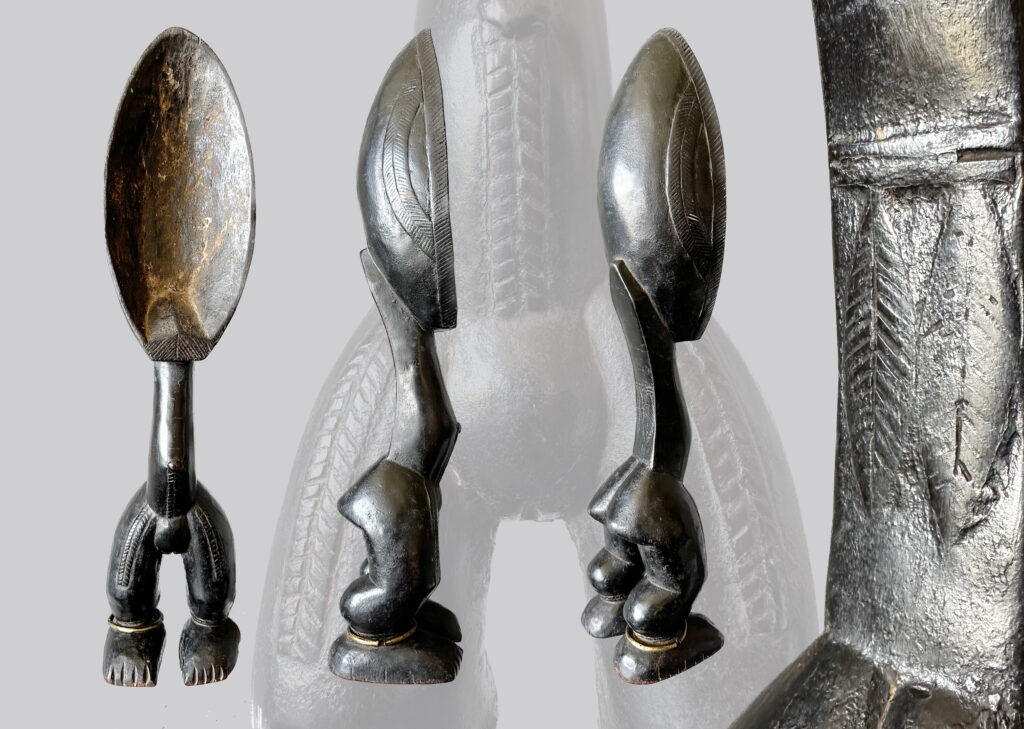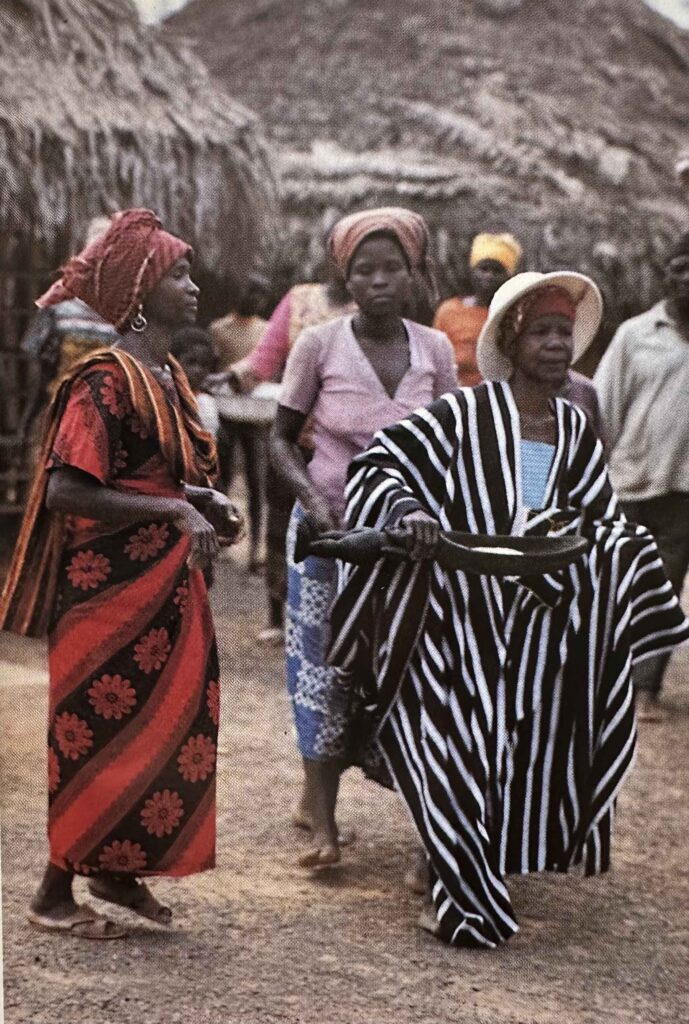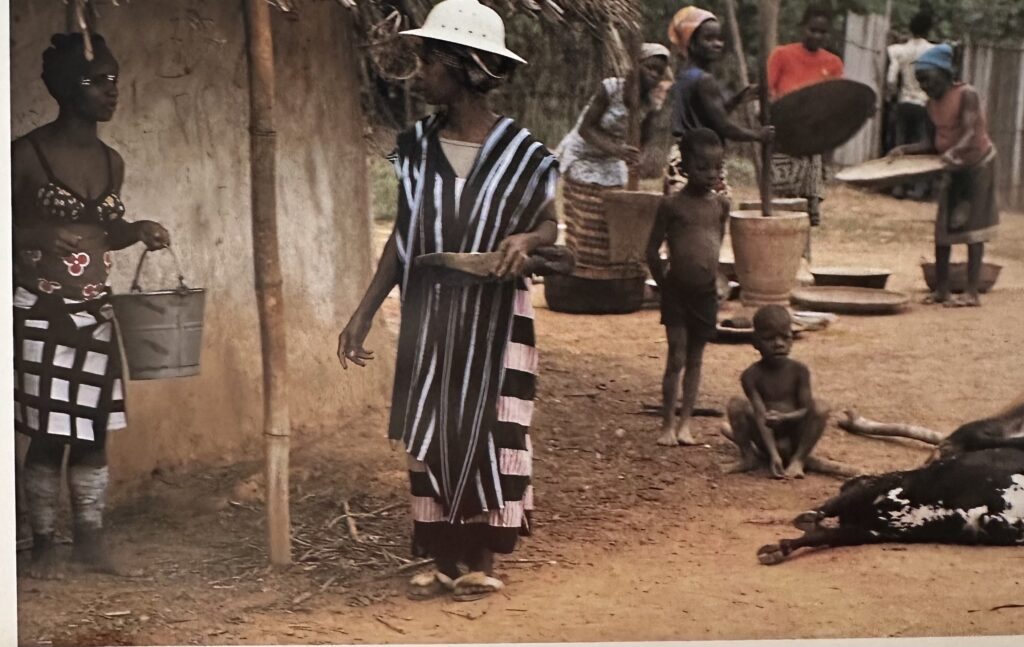
Un’icona: wakemia
E’ un’oggetto diventato iconico. le forme ardite ma perfette nella loro armonia misteriosa sprigionano una potenza archetipale. Appare istintivamente normale pensare ad una figura femminile, all’essenza della della figura femminile. Le gambe, il sesso pronunciato, l’insieme della parte centrale sono esplicite, ma avere concentrato nella parte alta, dove nella realtà si trova la testa, una grande forma concava non è solo funzionale all’uso per cui questo oggetto è pensato, ma racconta con una immagine la qualità sapienziale femminile: raccogliere la vita, custodirla, nutrirla. In questo semplice oggetto d’uso c’è l’essenza dell’alfabeto metaforico usato dalle culture Primarie, cosi semplice nell’evocare narrazioni sugli aspetti più significativi dell’esperienza umana.
E’ tra gli oggetti più ricercati ( e costosi ) nel mercato delle Arti Primarie. I più blasonati fanno nelle aste cifre a cinque zeri. Ed inesorabilmente è tra i più falsificati, fatto che porta chi acquista i pedigree invece della qualità a non prendere in considerazione quasi mai gli Wakemia senza provenienza certa, anche perché non è semplice distinguere un’opera originale da una copia ben fatta.

In questo caso l’oggetto dichiara la sua autenticità sia grazie al suo rigore formale, sia alla patina d’uso; è evidente che l’usura delle scarificazioni riprodotte nella parte centrale non può essere stata fabbricata ad arte.
E’ doverosa qualche informazione specifica : questo cucchiaio wakemia ( 0 wunkirmian ) è espressione della cultura del popolo Dan ( Costa d’Avorio ), è realizzato in legno duro con una patina molto scura, e misura 49,8 centimetri di altezza. E’ stato raccolto in situ oltre vent’anni fa ma ragionevolmente risale alla metà del secolo scorso; venne messo al riparo dai saccheggi e dal vandalismo legati alla lunga serie di guerre che hanno dilaniato quelle terre ed è stato gelosamente custodito per lunghi anni ad Abidjan da un noto antiquario locale e poi dai suoi nipoti.
” I grandi cucchiai cerimoniali sono scolpiti per onorare una specifica donna Dan di che si è distinta nella comunità di origine per generosità e ospitalità. Nelle ricorrenze importanti danza con il cucchiaio e dirige la distribuzione del riso ai convenuti. Divenuta anziana e riconosciuta come autorevole, passa il cucchiaio e il prestigio che ne deriva a colei che ritiene essere la più adeguata a succederle. I cucchiai sono conosciuti con molti nomi, tra cui wakemia o wunkirmian, che si traduce approssimativamente come “cucchiaio associato alle feste”. I cucchiai hanno dimensioni variabili da un piede a due piedi e hanno una o (raramente) due palette concave parallele. Il manico del cucchiaio è sempre decorato e spesso è legato alla forma umana e spesso presenta un paio di gambe come questo esemplare.
Tra i Dan, la proprietaria del cucchiaio è chiamata wa ke de, “donne che recitano alle feste”. È un titolo di grande distinzione, e viene viene dato alla donna più ospitale del paese. Con l’onore, tuttavia, viene la responsabilità di preparare la grande festa che accompagna le cerimonie mascherate. Dovendo accogliere e celebrare adeguatamente gli spiriti mascherati, le wa ke devono avere eccellenti capacità agricole, talento organizzativo e abilità culinarie i.
Quando una donna è stata scelta come padrona di casa principale per un simile evento, sfila per la città portando il cucchiaio grande come emblema del suo status. Il giorno della festa balla per il villaggio vestita da uomo perché “solo gli uomini sono presi sul serio”. Porta con sé un wunkirmian e mostra una ciotola piena di piccole monete o riso. Con l’aiuto dei suoi numerosi assistenti (di solito parenti o amiche), distribuisce cereali e monete ai bambini della comunità mentre balla e canta una speciale canzone con voce stridula. Il ventre profondo del cucchiaio da cui viene dispensata questa generosità diventa il corpo simbolico o grembo della figura femminile. L’evento crea una profonda analogia visiva che onora la padrona di casa, e le donne in generale, come fonte di cibo e di vita.
Oltre ad essere emblemi d’onore, i wunkirmian hanno anche un potere spirituale. Sono il principale collegamento di una donna Dan con il potere del mondo degli spiriti e un simbolo di quella connessione. Tra i Dan, ai wunkirmian è stato assegnato un ruolo tra le donne paragonabile a quello che le maschere svolgono tra gli uomini. In molti casi, i wunkirmian sono presenti nelle stesse cerimonie con maschere, lanciando riso davanti a loro come benedizione mentre procedono attraverso il villaggio. (Fonte: Metropolitan Museum of Art)

It is an object that has become iconic. the bold but perfect shapes in their mysterious harmony release an archetypal power. It seems instinctively normal to think of a female figure, of the essence of the female figure. The legs, the pronounced sex, the whole of the central part are explicit, but having concentrated in the upper part, where the head is actually located, a large concave shape is not only functional to the use for which this object was designed, but it tells with an image the female sapiential quality: gathering life, guarding it, nourishing it. In this simple object of use there is the essence of the metaphorical alphabet used by Primary cultures, so simple in evoking narratives on the most significant aspects of human experience. It is among the most sought after (and expensive) objects in the Primary Arts market. The most famous ones make five-figure figures in auctions. And inexorably it is among the most falsified, a fact that leads those who buy pedigrees instead of quality to almost never take into consideration Wakemias without certain provenance, also because it is not easy to distinguish an original work from a well-made copy. In this case the object declares its authenticity both thanks to its formal rigor and the patina of use; it is evident that the wear of the scarifications reproduced in the central part could not have been artfully manufactured. Some specific information is required: this wakemia spoon ( 0 wunkirmian ) is an expression of the culture of the Dan people ( Ivory Coast ), is made of hard wood with a very dark patina, and measures 49.8 cm in height. It was collected in situ over twenty years ago but reasonably dates back to the middle of the last century; it was sheltered from looting and vandalism linked to the long series of wars that tore those lands apart and was jealously guarded for many years in Abidjan by a well-known local antique dealer and then by his nephews. "Large ceremonial ladles are carved to honor a particular Dan woman from each village quarter who has distinguished herself among her fellow women by generosity and hospitality. At special feasts, she dances with the ladle and directs the distribution of rice to those assembled. An elderly honouree passes the ladle and the honour on to the one she sees fit as a successor. Artists in Dan communities of the Guinea coast have mastered the art of carving impressive, large wooden spoons that are virtuos works of sculpture. The spoons are known by many names, including wake mia or wunkirmian, which roughly translates as “spoon associated with feasts.” The spoons range in size from a foot to two feet and have one or (rarely) two parallel bowls. The handle of the spoon is always decorated and often is related to the human form and often feature a pair of legs like this example. Among the Dan, the owner of the spoon is called wa ke de, “at feasts acting woman.” It is a title of great distinction that is given to the most hospitable woman of the village. With the honor, however, comes responsibility—the wa ke de must prepare the large feast that accompanies masquerade ceremonies. The excellent farming abilities, organizational talents, and culinary skills of the wa ke de are called upon to properly welcome and celebrate the masquerade spirits. When a woman has been selected as the main hostess of such a feast, she parades through town carrying the large spoon as an emblem of her status. On the day of the feast, she dances around the village dressed in men’s clothes because “only men are taken seriously.” She carries with her a wunkirmian and displays a bowl filled with small coins or rice. With help from her numerous assistants (usually female relatives or friends), she distributes grains and coins to the children of the community while dancing and singing her special shrill song. The deep belly of the spoon from which this bounty is dispensed becomes the symbolic body or womb of the female figure. The event creates a profound visual analogy that honors the hostess, and women in general, as a source of food and life. In addition to being emblems of honor, wunkirmian also have spiritual power. They are a Dan woman’s chief liaison with the power of the spirit world and a symbol of that connection. Among the Dan, the wunkirmian have been assigned a role among women that is comparable to that which masks serve among the men. In many instances, wunkirmian are featured in the same ceremonies with masks, tossing rice in front of them as a blessing while they proceed through the village.(Source: Metropolitan Museum of Art)
Giuliano Arnaldi, Onzo 26 giugno 2023